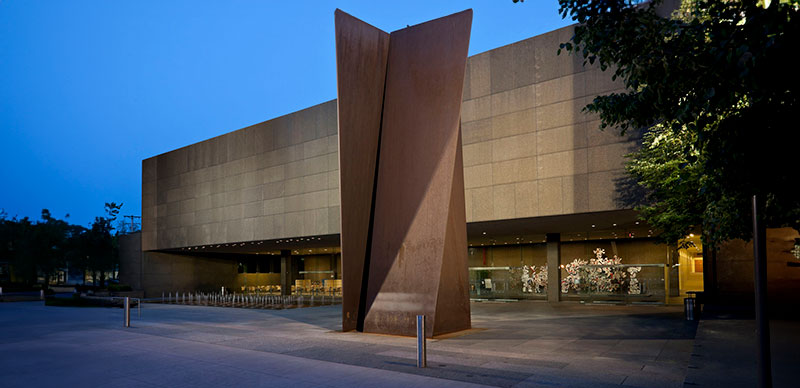On a late-summer Sunday afternoon, a corner of Trace Brewing in Pittsburgh’s Bloomfield neighborhood bustles with artists of all ages. While some chat away next to beer pints and coffee mugs, others work in steady concentration—everyone’s fingers busily crocheting vibrantly hued ruffles of yarn.
These individual crochet creations—produced during sessions like the one at Trace—form the Pittsburgh Satellite Reef installation now on display at Carnegie Museum of Art through Jan. 26, 2025. Created by local makers, it’s part of a worldwide “Crochet Coral Reef” project meant to highlight the threat of climate change to ocean habitats.
As they toil away, some artists have someone special in mind, designing an homage with their craft. Lois Bowser, 59, present at the Trace event, says it evokes fond childhood memories of nightly crochet sessions with her grandmother.
Other participants remain focused on the core mission of this community art project—bringing awareness to coral and water health, and the part that we humans play in their conservation. Tara Briggs, 30, has been crocheting for about 13 years and has made four corals. “This project felt important and special because it allowed me to use my favorite hobby to contribute to a larger purpose,” she says.
“When looking for an exhibition this fall, I really wanted one that honored the interdisciplinary nature of the space,” explains Alyssa Velazquez, curatorial assistant in decorative arts and design at Carnegie Museum of Art, noting that the coral reef’s location in the museum’s Charity Randall Gallery also is a short walk from Carnegie Museum of Natural History’s Hillman Hall of Minerals and Gems.
She came across The Institute For Figuring, a Los Angeles-based nonprofit that works with museums to create programming with science and mathematical themes, and the Crochet Coral Reef, an evolving nature-culture blend dreamt up by sisters Margaret and Christine Wertheim in response to the ongoing destruction of coral reefs.
Coral reefs are critical to the health of marine environments, but climate change has had devastating impacts. It’s estimated that 30 percent will be destroyed or seriously degraded in the next 10 years, according to the U.S. Geological Survey.
In the fall of 2022, Velazquez reached out to Margaret, saying that the Museum of Art, too, wanted to host a satellite reef. (As of late 2023, there were 52 sites worldwide.) Velazquez thinks Pittsburgh makes perfect sense as a site for the project, considering the city’s celebrated rivers. “This project creates spaces among our three rivers to confront, resist, and imagine an alternative to an oceanic crisis that continues to be impacted by our local watercourses,” she says.
The contributions of Andrew Eppich, 58, feature coral-colored yarn, plus gray and muted accents to symbolize dead coral and the environmental crisis. Eppich is also a member of Three Rivers Fiber Focus, which he says is a big supporter of the coral reef project.
“This project creates spaces among our three rivers to confront, resist, and imagine an alternative to an oceanic crisis that continues to be impacted by our local watercourses.”
–Alyssa Velazquez, curatorial assistant in Decorative Arts and Design at Carnegie Museum of Art
“[The destruction of coral reefs] is important to me and should be for everyone,” he says, “because it creates such a chain reaction for the ecosystem that reaches marine life, the environment, and global finances once the life that used to be sustained by the reefs is gone. Why not start by creating awareness right in our own backyards?”
The museum hosted a series of workshops over the spring and summer of 2023 at western Pennsylvania-based Kid Ewe Knot—which is dedicated to “spreading the love of fiber, craft, and crochet”—and the environmental advocacy organization UpstreamPgh. The goal was to introduce experienced and beginner makers to the techniques of crocheting a coral out of yarn. Other workshops took place at venues that facilitated making art and conversation—like Trace Brewing, Pittsburgh Zoo and Aquarium, and Carnegie Museum of Art, and gatherings of Carnegie Mellon University’s Yarnivores and meetings of the Madwomen in the Attic Creative Writing Program at Carlow University.
A community developed as the project progressed, creating what Velazquez calls a “caravan of crocheters.” In total, 281 individuals participated; and folks mailed in contributions from afar, too.
Heather Metzger, the founder of Kid Ewe Knot, notes a “great enthusiastic response” at the events. As a true believer in research that deems crafting “good for our mind, body, and spirits,” Metzger supports the powerful meaning of this project. It’s been a way for people to share dialogue, enjoy art together, and ponder: What can we do as individuals and community?
Every crafter has their name listed as a contributing artist in the exhibition. Kaleb Noble, 35, picked up his craft more than 13 years ago. He’s created 10 pieces, and says that, from an environmental standpoint, the project has allowed him to reduce his stash of acrylic yarn. “Yarns made from rayon, polyester, and other synthetic fibers release microfibers into water when washed,” he says, “which can end up polluting the ocean and other bodies of water.”
Velazquez is especially excited about the participation of anyone who has ever dreamt of working in the fine arts, including her own cousin-in-law. Now she, and community members like her, can see their work on display at the Museum of Art. The project makes space for those who might not otherwise have had the opportunity. Says Velazquez, “The exhibition is as much about corals as it is about its correlations.”
Pittsburgh Satellite Reef is generously supported by The Charity Randall Foundation.







